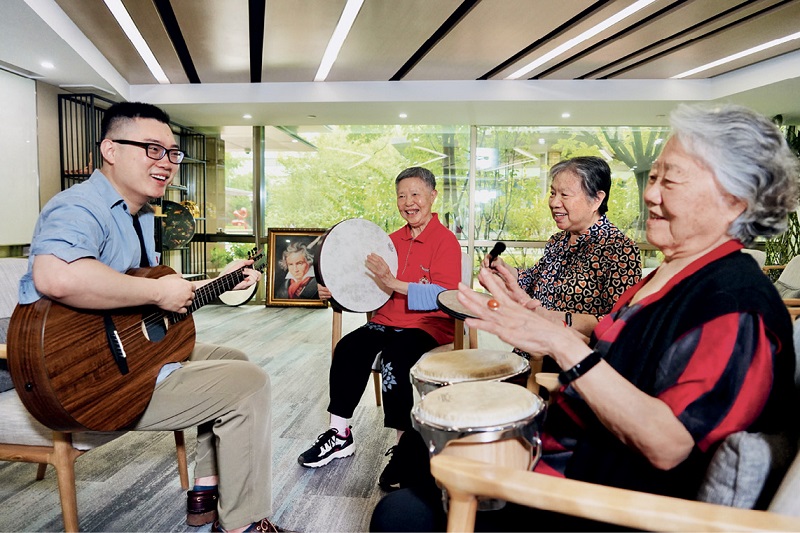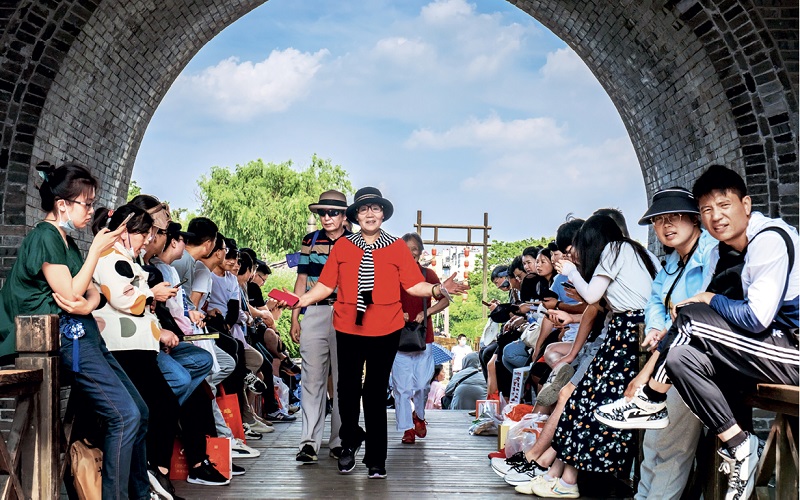Developing the silver economy is not only a requirement for enhancing services for the elderly, but also an important part of achieving China's high-quality development.
China's latest Central Economic Work Conference held in December 2023 emphasized the need to accelerate the improvement of a childbearing supportive policy system and develop the silver economy.
As a result of the rapidly aging population in China, the silver economy has risen to an unprecedented height in China’s development strategy. From concept to action, the silver economy has become a significant part of China’s active response to such national issues as population aging, boosting domestic demands, and achieving high-quality development.

Retired seniors having a great time during a session of music therapy.
Laying a Solid Foundation
The silver economy refers to the industrial clusters and economic activities that have formed within the context of an aging population and an aging society. Its diversified industrial system involves a long industrial chain, covering almost all categories of the national economy.
Population aging is a dynamic process in which the number of elderly people in the total population is increasing and the level of aging is rising, the results of which create both challenges and opportunities. The silver economy exactly embodies the opportunity of an ageing population. From the perspective of the process of life, the elderly have entered the life stage of being pure consumers after leading a life of production, and the increase in elderly population in society means there is a corresponding increase in dependency ratio. From the perspective of economic demand, senior citizens have become an increasingly important consumer group in economic development, and their consumption demands have become key factors that affect the total economic demand.
China’s elderly population aged 60 and above reached 130 million in the year 2000, ushering in an aging society. The aging of Chinese’s population has five characteristics. First, it is a large number of people. The number of elderly people will double from 264 million in 2020 to 520 million by the middle of this century, ranking the largest in the world, while at the same time creating the world’s largest elderly consumer market. Second, it is growing at a rapid speed. The share of senior citizens in the national population will more than double from 18.7 percent in 2020 to above 40 percent by the middle of this century, forming a super-aging society. Third, after the middle of this century, the level of aging will maintain a rate of more than 40 percent of national population, ranking China as one of the world's high aging countries. Elderly people’s demand and consumption will become the mainstream of social demand and consumption. Fourth, it is stable. The form of a super-aging society will continue until after the middle of this century, forming a stable and long-term large-scale consumer demand. Fifth, this group has shown great diversities in the region, age, health, income, and social groups, creating a diversified consumer demand.
The impact of this aging population on China’s economic and social development is profound, long-term, and comprehensive. Chinese modernization is one of a huge population, covering people of all ages including the elderly population. The growing demands of this population group have laid an important foundation for the development of the silver economy.
Huge Market Potential
Every person has the dual identities of being a producer and a consumer. Producers who provide labor for the operation of the economy exist only during a certain stage of the human life cycle, while as consumers, their consumption behavior runs throughout their whole life. The endogenous and systemic impact of population aging on economic growth shapes the relationship between population and economy. Population aging has brought undeniable pressure on the economy and society, such as labor scarcity, declining potential of the economy’s growth rate, and an increasing burden on social support. But the more challenges that emerge, the more we must cherish the opportunity we have to meet them. On the one hand, from the perspective of consumption, the growing elderly population is an increasingly important potential consumer group, and will eventually become the main body to promote consumption and expand domestic demand. On the other hand, with the structural change of the elderly population, consumption upgrading represents the general trend. People born between the 1950s and 1970s that have benefited from the dividends of China’s reform and opening-up have gradually become senior citizens. Compared with their predecessors born during the war times and eras of conflict that suffered from material scarcity, the concepts, capabilities, habits, preferences, and patterns of consumption among the new elderly have shown great changes, generating new consumption demands and new business models, and giving birth to a new market space of silver economy.
The Fudan Institute on Aging predicts that based on the moderate growth rate of per capita consumption, the scale of the silver economy will be RMB 19.1 trillion in 2035, accounting for 27.8 percent of total consumption and 9.6 percent of China’s GDP. The scale of the silver economy will be RMB 49.9 trillion in 2050, accounting for 35.1 percent of the total consumption and 12.5 percent of China’s GDP. The number of China’s elderly people is expected to reach 300 million in 2025, more than 400 million in 2033, and 500 million in 2049, rendering China the country with the largest elderly population in the world till 2070. In a word, from now to the middle of this century, China will have both the world’s largest elderly consumer group and the world's largest elderly consumer market, opening up a broad space for the development of the silver economy. Thus the key to meet this challenge is transforming the inherent potential consumer market, which is based on the large size of the elderly population, into an effective consumer market that is based on consumption power.

Fashionably dressed elderly people walk through the Dongguan City Gate Tower in Yangzhou, Jiangsu Province on June 11, 2023.
Creating New Business Models
Promoting silver consumption and developing the silver economy does not just entail enhancing services for the elderly, and improving the quality of these people’s lives. It is also an important part of achieving high-quality development of China.
First, a positive concept of aging should be used in developing the silver economy. Active aging is the basic concept that defines the action plans pursued by the international community and China to respond to the needs of the aging society. According to the World Health Organization, active aging is the process by which older people improve their quality of life and maximize their opportunities for health, participation, and security. It also enables the elderly to maintain a good physical, social, and psychological state, actively face their old age, and continue to make contributions to their families and society. Developing the silver economy not only helps meet the consumption needs of the elderly, but also helps expand domestic demand which will promote economic growth as a result. Senior citizens are not outsiders to the growth of the silver economy, they support social wealth rather than burden it. Recognizing and giving full play to the role of the huge elderly population in driving economic growth is important to economic growth and economic development at a higher and broader level.
Second, we should give full play to the respective roles of the government and the market in the silver economic system, and promote the coordinated development of the related industries for the elderly, as well as various public services they need. The silver economy has its particularity, and the government needs to make up for the shortcomings of the market economy mechanisms when necessary.
On the one hand, the government should ensure inclusiveness is realized based on the principle of fairness, strive to meet the basic needs of all the elderly, increase inclusive services, and build a comprehensive social security network for the elderly. Meanwhile, the government should formulate quality standards for elderly products and services, standardize and supervise market activities, and promote the scale, clustering, and brand building of the silver economy. On the other hand, it is necessary to actively allow the role of the market to play out, adhering to the principle of efficiency. Based on this principle, the country should promote the market allocation of aging industry resources, guide and encourage all kinds of market entities to actively participate, increase elderly products and services, foster real estate and finance for elderly care, and cultivate new industries, new business forms, and new business models.
Third, we should build a systematic aging industry system. To promote the development of the silver economy, it is necessary to draw plans based on the overall situation of high-quality economic development.
The aging industry is the support of the silver economy, and in the long run, to improve the top-level design of the aging industry, attention should be paid to at least six areas. First, the cultural industry: it should provide cultural products and services, such as lifelong learning and artistic creation, helping people achieve a long and happy life. Second, the health industry: the country should adhere to positive and healthy aging concepts and build a health service system that adapts to the aging society, providing such services as health management and digital health services, helping people live long and well. Third, the manufacturing industry: it should match the structure, preferences, levels, directions, and characteristics of new needs and new consumption in the era of aging and longevity, such as daily necessities and smart devices, helping people achieve a long and quality life. Fourth, the housing and related industries: they should stay in line with the great changes in the aging society, such as architectural design and real estate services, helping people achieve a long and quality life. Fifth, the service industry: it should involve all aspects of life service, such as catering and housekeeping, helping people achieve a long and secure life. Sixth, the financial industry: it should provide financial preparations for elderly care and promotes better allocation of financial assets, such as insurance and real estate, helping people achieve a long and abundant life.
The development of the silver economy depends not only on government efforts, but also the market. It is not only necessary to advance the cause of the elderly, but also to promote the development of the aging industry. To promote and achieve this end, we need to rely on not only individuals and families, but also the government, society, and the market. Taking a positive view of the huge elderly population, stimulating the vitality of the silver economy, and expanding the silver economy will not only meet the consumption needs of the elderly and improve their well-being, but also expand domestic consumption, promote the development of related industries, create new economic growth points, and better promote high-quality population development to support China’s modernization efforts. 
Professor YUAN XIN is the director of the Institute of Population and Development of Nankai University.